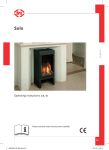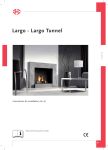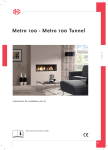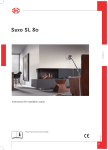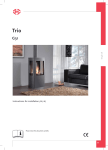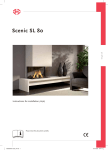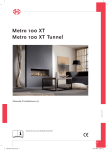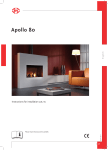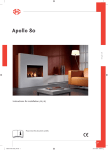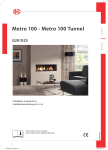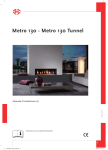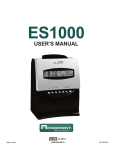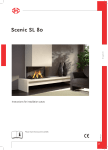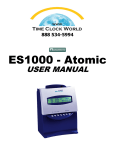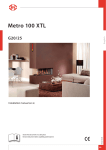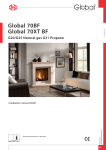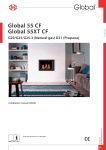Download Metro 100 XT Metro 100 XT Tunnel
Transcript
English Metro 100 XT Metro 100 XT Tunnel Instructions for installation (GB / IE) Please retain this document carefully 1 UK 95901203UK Install_UK.indd 1 6-4-10 13:29 M E T R O 1 00 XT - I N S T R U C T I O N F O R I N S TA L L AT I O N Contents English Preface 1. Introduction 2. CE declaration 3. SAFETY 3.1 General 3.2 Regulations 3.3 Precautions / safety instructions during installation 4. Instructions 5. Removing the packaging 6. Installation 6.1 Regulations 6.2 Type of gas 6.3 Gas connection 6.4 Placing the appliance 6.5 Flue gas discharge / combustion air supply system 6.6 Placing the chimney breast 6.7 Placing the control box 6.8 Adjusting the appliance 6.9 Placing the wood/pebble set 6.10 Glass window 7. Wireless remote control 7.1 Receiver 8. Final check 8.1 Gastightness 8.2 Gas pressure / pre-pressure 8.3 Ignition pilot and main burner 8.4 Flame image 9. Maintenance 10. Delivery 11. Malfunctions Appendix 1 Parts included with the delivery Appendix 2 Technical data Appendix 3 Parts Page 3 3 3 4 4 4 4 4 4 5 5 5 5 5 6 10 11 11 12 17 19 19 20 20 20 20 20 21 22 23 25 25 25 UK 2 95901203UK Install_UK.indd 2 6-4-10 13:29 M E T R O 10 0 XT - I N S T R U C T I O N F O R I N S TA L L AT I O N Preface English DRU, a manufacturer of gas heating appliances, develops and produces products that comply with the highest quality, performance and safety requirements. This guarantees that the user will be able to enjoy using his product for many years to come. This appliance has a CE marking, which means that it complies with the essential requirements of the European gas appliance directive. Two manuals are supplied with the appliance: the installation manual and the user manual. As an installer, you must be competent in the field of atmospheric gas heating. The installation manual will give you the information you need to install the appliance in such a way that it will operate properly and safely. This manual discusses the installation of the appliance and the regulations that apply to the installation. In addition, you will find technical data for the appliance and information on maintenance, any malfunctions that might occur and their possible causes. Please carefully read and use this installation manual. The following symbols are used in the manual to indicate important information: ➠ Work to be performed !Tip Suggestions and recommendations !Caution You will need these instructions to prevent problems that might occur during installation and/or use. Caution You need these instructions to prevent fire, personal injury or other serious damages. After delivery, you should give the user manual and this installation manual to the user. 1. Introduction The appliance is supplied in 2 versions, the Metro 100 XT and the Metro 10 XT Tunnel. The Metro 100 XT is a “standard” appliance. It is always mounted against a wall. The Metro 100 XT Tunnel is a “look-through appliance”; it has a pane at the font and back. The Metro 100 XT and the Metro 100 XT Tunnel are closed atmospheric gas heating appliances. A closed appliance does not extract the combustion air from the living environment, but from outside. This is done through a combined flue gas discharge system / combustion air supply system. In this concentric system the outer pipe serves as air supply and the inner pipe as flue gas discharge. This system can be installed through the wall, or through the roof. These appliances are built within a chimney breast. For this, DRU has a number of chimney breasts in its programme. The chimney breast must be ventilated, for a proper heat discharge. DRU is able to supply various ventilation elements. The appliances are supplied with a wireless remote control that works on batteries. 2. CE declaration We hereby declare that the design and construction of DRU’s atmospheric gas heating appliance comply with the essential requirements of the Gas Appliance Directive. This declaration will lose its validity if adjustments are made to the appliance, without prior written permission by DRU. Product: atmospheric gas heating appliance Type: Metro 100 XT Metro 100 XT Tunnel Applicable EEC directives: 90/396/EEC Applied harmonized standards: NEN-EN-613 NEN-EN-613/A1 Internal measures by the company guarantee that appliances produced in series comply with the essential requirements of the prevailing EEC directives and the standards derived from them. M.J.M Gelten Algemeen directeur Postbus 1021, 6920 BA Duiven Ratio 8, 6921 RW Duiven www.dru.nl 3 UK 95901203UK Install_UK.indd 3 6-4-10 13:29 M E T R O 1 00 3. XT - I N S T R U C T I O N F O R I N S TA L L AT I O N SAFETY 3.1 General Caution - Carefully read this chapter on safety, before you start performing installation or maintenance work; - Please observe the general regulations and the precautions/safety instructions in this manual. 3.2 Regulations Please install the appliance in accordance with the applicable national, local and constructional (installation) regulations. 3.3 Precautions / safety instructions during installation English Carefully observe the following precautions/safety regulations: ➠ ➠ ➠ ➠ ➠ ➠ ➠ ➠ ➠ ➠ ➠ ➠ ➠ ➠ ➠ ➠ ➠ ➠ ➠ ➠ ➠ ➠ 4. you should only install and maintain the appliance if you are a competent installer in the field of atmospheric gas heating; do not make any changes to the appliance; use inflammable and heat-resistant materials for building a chimney breast, including the back wall, the inside and the top of the chimney breast; comply with the minimum required internal measurements of the chimney breast; ventilate the chimney breast by means of the ventilation holes, which will form a combined passage of at least 200 cm2; only use the flue gas discharge / combustion air supply system supplied by DRU; mount the appliance using the wall brackets supplied; do not place the appliance too tightly against the back wall; make sure the space between the appliance’s legs is kept free; do not cover the appliance and/or do not wrap it in an insulation blanket or any other material; make sure that combustible objects and/or materials have a distance from the appliance of at least 500 mm; only ever use the supplied wood set; place the wood set exactly as described; make sure the pilot burner and the space around it is kept free; avoid dirt in gas pipes and connections; check the connections for gastightness before using the appliance; use heat resistant electrical connectors; place electrical connections in such a way that they are free from the appliance; check whether the pressure equalization hatches on top of the stove are securely positioned on the seat, prior to mounting the appliance; prevent blocking of the pressure equalization hatches; replace torn or broken panes; do not ignite the appliance until it is fully installed. Instructions Observe the following items during installation in order to guarantee a proper and safe operation of the appliance: ➠ ➠ ➠ ➠ ➠ ➠ ➠ ➠ 5. mount the control box supplied as low as possible; avoid that the ignition cable runs over the receiver; avoid that the ignition cable runs alongside metal parts, in order to prevent weakening of the spark; avoid that the ignition cable touches or crosses the antenna; properly finish the edges in case of a tight construction; do not apply plaster on or over the flanges; avoid damaging the pane during removal/placing; clean the pane before you use the appliance, in order to prevent dirt from burning in the glass. Removing the packaging Note the following items when removing the packaging: ➠ ➠ Check the appliance for damages during transport; If necessary, contact DRU Service. After removing the packaging, you should have the following components: - Socket spanner: you will find it in the space between the assembly frame and the combustion chamber; - Decorative strips: you will find them in the abovementioned space as well. After removing the glass pane, you can take the box with parts out of the combustion chamber. UK 4 95901203UK Install_UK.indd 4 6-4-10 13:29 M E T R O 10 0 XT - I N S T R U C T I O N F O R I N S TA L L AT I O N !Caution Avoid damaging the pane during removal/placing. Remove the glass pane as described in section 6.10.1; ➠ Remove the box containing parts from the combustion chamber. ➠ In appendix 1 / table 4 you can see which parts you should have after removing the packaging. ➠ ➠ Contact DRU Service if you do not have all the parts after you finished removing the packaging; Dispose packaging in accordance with local regulations. 6. Installation Read this manual carefully to ensure a proper and safe operation of the appliance. English !Caution Install the appliance in the order described in this chapter. 6.1 Regulations - Observe the applicable (installation) regulations; - Observe the regulations/instructions in this manual. 6.2 Type of gas The type plate indicates for which type of gas, gas pressure and for which country this appliance is intended. The type plate is connected to a chain. It should remain connected to the chain. !Caution Check whether the appliance is suitable for the type of gas and the gas pressure used at the location. 6.3 Gas connection Place a gas tap in the gas connection, close to the appliance. Caution Avoid dirt in the gas pipe and in the connections. The following requirements apply to the gas connection: - use a gas pipe with the correct dimensions, so that no pressure loss can occur; - the gas tap should have the CE marking; - you should always be able to reach the gas tap. ➠ Do not twist the gas tap when connecting the gas pipe. 6.4 Placing the appliance Place the appliance as follows: Caution - make sure that combustible objects and/or materials have a distance from the appliance of at least 500 mm; - Do not make any changes to the appliance. ➠ ➠ ➠ Determine the location of the appliance; Provide a gas connection at the location. For details, see section 6.3; Make a duct for the flue gas discharge/combustion air supply system with the following diameters. For details, see section 6.5. - Ø160 mm for a wall duct through incombustible material; - Ø 250 mm for a wall duct through combustible material; - Ø160 mm for a roof duct through incombustible material; - Ø 250 mm for a roof duct through combustible material. NJO NBY D 4JEFWJFX .FUSP95 NJO NBY 'SPOUWJFX Fig. 1 5PQWJFX 5PQWJFX 'SPOUWJFX D 4JEFWJFX .FUSP95UVOOFM 5 UK 95901203UK Install_UK.indd 5 6-4-10 13:29 M E T R O 1 00 XT - I N S T R U C T I O N F O R I N S TA L L AT I O N min 400 mm Metro 100 XT inside min 446 mm Metro 100 XT Tunnel inside min 1300 mm inside max 100 mm A min 1350 mm inside b A-A A c Total ventilation 200 cm2 English x 354 = Fig. 2 00 -13 38c 1008 Appliance Maximal plaster line = 8BMMCSBDLFUT Fig. 3 .FUSP95 Maximal plaster line 8BMMCSBDLFUT .FUSP955VOOFM Caution - take the depth of the appliance into account (see Fig. 2) (Metro 100 XT: min. 400; Metro 100 XT Tunnel: min. 446mm); - Take the build-in height of the appliance into account; it depends on the setting of the adjustable legs (see Fig. 1). Place the appliance on its destined location! ➠ The gas control block is mounted at the bottom of the appliance, to the burner plate. It should be disconnected and placed in the control box at a later stage. For placing the gas control block in the control box, see section 6.7 Follow the procedure described below: ➠ ➠ Disconnect the pipes of the gas control block (flexible gas pipe, aluminium pilot flame pipe and thermocouple); Disconnect the gas control block from the burner plate by unscrewing the parker. Caution - Avoid dirt in the pipes; - Avoid kinks in the pipes. Roll out the pipes in the direction of the control box; ➠ Roll out the ignition cable in the direction of the control box. ➠ !Caution The type plate should remain connected to the chain. Place the chain with the type plate in the direction of the control box; ➠ Set the height of the appliance and make it level at the same time. ➠ Caution - do not place the appliance too tightly against the back wall; - make sure the space between the appliance’s legs is kept free; - do not cover the appliance and/or do not wrap it in an insulation blanket or any other material. Connect the appliance to the wall using wall brackets and the wedge bolts supplied; see Fig. 3. ➠ 6.5 Flue gas discharge / combustion air supply system 6.5.1 General The appliance is of the C11/C31 type. The appliance is connected to a combined flue gas discharge/combustion air supply system, hereafter referred to as the concentric system. The passage to the outside can be made with a wall duct (see section 6.5.2) or a roof duct (see section 6.5.3). UK 6 95901203UK Install_UK.indd 6 6-4-10 13:29 M E T R O 10 0 XT - I N S T R U C T I O N F O R I N S TA L L AT I O N If necessary, you can also use an existing discharge channel (see section 6.5.4). At the factory, the appliance is made in such a way that it can be connected to vertical pipe of 1 up to 4 meter + 90° bend + wall duct. If this is the case, you do not have to make any changes to the appliance. If your situation is different, you must remove the air inlet guide as indicated in 6.8.2. On the appliance you should always start with a vertical pipe. You can start with a minimum vertical pipe of 0.5 meter and a maximum vertical pipe of 4 meter. Caution - Only use the concentric system supplied by DRU (Ø100 / Ø150 mm) and its accessories. This system was tested in combination with the appliance; DRU cannot guarantee a proper and safe operation of other systems and cannot accept liability for these systems. - For connecting to an existing chimney flue you should only use the installation set supplied by DRU. English The concentric system is constructed from (the discharge stump of) the appliance. If structural circumstances require that the concentric system is placed first, the appliance can later be connected with a telescopic pipe piece. 6.5.2 Application with wall terminal 6.5.2.1 Construction of concentric system with wall terminal The concentric system with wall terminal has to comply with the following conditions: - First, a concentric pipe of at least 0.5 meters should be connected vertically to the appliance; - The total vertical pipe length may have a maximum of 4 meters; - A 90° bend is connected to the other end of the vertical part; - When using 0.5 meter of vertical pipe length, the total horizontal pipe length can have a maximum of 1 meters (excluding wall terminal, see fig. 4a); - When using a minimum of 1 meter up to a maximum of 4 meters of vertical pipe length, the total horizontal pipe length can have a maximum of 3 meters (excluding wall terminal, see fig. 4b). Depending on the construction of the concentric system, the appliance must receive further settings; see Table 1 for determining the conditions and section 6.8, Adjusting the appliance, for the method. Table 1: Conditions for the adjustment of the appliance with a wall terminal G20/25 Total number of meters vertical pipe length See figure Total number of meters horizontal pipe length (excluding wall terminal) Air inlet guide Baffle Distance of restriction in mm 0,5 0-1 4a NO NO OPEN 1-4 >0 - 3 4b NO NO OPEN 1-4 0* YES NO OPEN * factory setting Y N N Y D D NBYN Fig. 4a NBYN Fig. 4b 6.5.2.2 Placing the concentric system. Place the concentric system as follows: ➠ build the system up from (the connection stump of) the appliance. Caution - maintain a distance of at least 50mm between the outside of the concentric system and the walls and /or ceiling. If the system will be built in (for instance) a cove, it should be fully made of incombustible material; 7 UK 95901203UK Install_UK.indd 7 6-4-10 13:30 M E T R O 1 00 XT - I N S T R U C T I O N F O R I N S TA L L AT I O N English - use heat-resistant isolation material when passing through combustible material; - the rosette (mounting inner plate) of the wall duct is too small to seal the Ø 250 mm opening when passing through combustible material. That is why you should first apply a sufficiently large heat-resistant intermediate plate to the wall. Then, the rosette is mounted on the intermediate plate. connect the concentric pipe pieces and the bend(s); ➠ on each connection, apply a clip binding with silicon sealing ring; ➠ use a parker to fix the clip binding to the pipe on locations that cannot be reached after installation; ➠ apply sufficient clamps, so that the weight of the pipes does not rest on the appliance; ➠ determine the remaining length of the wall duct; ➠ make sure the wall duct has the right dimensions. ➠ Caution - make sure that the right insertion length is maintained; - place the wall duct with the groove/folded seam at the top; - make sure the horizontal concentric pipe pieces are sloping towards the wall duct, in order to prevent rain water from entering. mount the rosette (mounting inner plate); if necessary, on a heat resistant intermediate plate when passing through ➠ combustible material; attach the wall duct from the outside with four screws in their respective holes. ➠ Caution - some heat-resistant isolation materials contain volatile components that will spread an unpleasant smell for a prolonged time; these are not suitable. 6.5.3 Application with roof duct 6.5.3.1 Construction of concentric system with roof duct The concentric system with roof duct has to comply with the following conditions: - the construction of the chosen system has to be allowed. (See the procedure described below); - first, a concentric pipe of at least 1 meter should be connected vertically to the appliance. Depending on the construction of the concentric system, the appliance is set by placing the baffle and/or removing the air inlet guides. In the following procedure you can see how the allowability of a concentric system can be determined and which settings are needed. ➠ Determine the following data: The number of bends required (no distinction is made between 45° and 90° bends); The total number of meters of horizontal pipe length; The total number of meters of vertical and/or sloping pipe length. With these data and Table 2 you will be able to determine whether the concentric system is allowed. In Table 3 you can see which setting the appliance needs. Follow the procedure described below: ➠ ➠ In the first 2 columns of Table 2, look for the number of bends required and the total horizontal pipe length: In the 3rd column of Table 2, look for the total vertical and/or sloping pipe length. If you end up in a box with the letter A, B, C, D or E, the concentric system chosen by you is allowed. ➠ Use Table 3 to determine which conditions apply for the baffle and/or the air inlet guides (for setting, see section 6.8). Examples To clarify, we will give 2 examples to determine the allowability of a concentric system and the conditions for setting the appliance. In Table 2 the route to be followed is indicated by arrows. The result is indicated by means of a circle. Example 1 1) 2 bends 2) 3 meters horizontal 3) 8 meters vertical/sloping → Construction of this concentric system is allowed. → Situation C applies for setting the appliance Example 2 1) 3 bends 2) 4 meters horizontal 3) 9 meters vertical/sloping → Construction of this concentric system is not allowed. UK 8 95901203UK Install_UK.indd 8 6-4-10 13:30 M E T R O 10 0 XT - I N S T R U C T I O N F O R I N S TA L L AT I O N Table 2: Conditions for setting appliance with roof duct Total number of meters horizontal pipe length Total number of meters vertical and/or sloping pipe length 1 2 3 4 5 6 7 앗8 앗9 10 11 12 no bends 0 B C C D D D D E E E E E 2 bends 0 A A B C C D D D D E E E A A B C C D D D D E A A B C C D D D A A B C C D A A B C 1 2 씮 3 4 English G20 / G25 5 3 bends 0 A 1 A A B C C D D D D E A A A B C C D D D D A A A B C C D D A A A B C C A A A B 2 3 씮 4 4 bends 0 E 5 A 1 A A A B C C D D D D A A A A B C C D D D A A A A B C C D A A A A B C A A A A 2 3 4 E 5 5 bends - ■ = Construction is not allowed Table 3: Conditions for setting appliance with roof duct Situation Air inlet guide Baffle Distance restriction A NO NO OPEN B YES YES 48 mm C YES YES 43 mm D YES YES 38 mm E YES YES 33 mm 6.5.3.2 Placing the concentric system The roof duct can end in a sloping and a flat roof. The roof duct can be supplied with an adhesive plate for a flat roof or with a universally adjustable tile for a sloping roof. Place the concentric system as follows: ➠ Build the system up from (the connection stump of) the appliance. Caution - Maintain a distance of at least 50 mm between the outside of the concentric system and the walls and/or the ceiling. If the system is built in (for instance) a cove, it should be made with incombustible material all around it; - Use heat-resistant isolation material when passing through combustible material. !Caution Some heat-resistant isolation materials contain volatile components that will spread an unpleasant smell for a prolonged time; these are not suitable. Connect the horizontal (lacquered) concentric pipe pieces and, if necessary, the bends; ➠ On each connection, apply a (lacquered) clip binding with silicon sealing ring; ➠ Use a parker to fix the clip binding to the pipe on locations that cannot be reached after installation; ➠ Apply sufficient clamps, so that the weight of the pipes does not rest on the appliance; ➠ Determine the remaining length of the roof duct; ➠ Make sure the roof duct has the right dimensions. ➠ 9 UK 95901203UK Install_UK.indd 9 6-4-10 13:30 M E T R O 1 00 XT - I N S T R U C T I O N F O R I N S TA L L AT I O N !Caution Make sure that the right insertion length is maintained. Connect the roof duct to the concentric pipes. ➠ !Caution - Make sure that the universal tile fits well with the surrounding tiles; - Make sure that the adhesive plate fits well onto the flat roof. 6.5.4 Connection of existing chimney flue English It is possible to connect the appliance to an existing channel. A flexible SS pipe is placed in the chimney for discharging flue gases. The surrounding space is used to supply combustion air. The following requirements apply when connecting to an existing chimney flue: - only allowed when used in combination with the special DRU chimney installation set. The installation regulation is also supplied; - the dimensions should be at least 150 x 150 mm; - the vertical length has a maximum of 12 meters; - the horizontal length has a maximum of 3 meters; - the existing chimney flue has to be clean; - the existing chimney flue has to be closed. 6.6 Placing the chimney breast The appliance is designed to be mounted tightly in a new chimney breast. In order to provide proper heat discharge, there should be sufficient space around the appliance. The chimney breast should be ventilated sufficiently by means of ventilation holes. !Caution - use incombustible and heat resistant material for the chimney breast, including the chimney breast’s back wall; The ventilation holes - which should be mounted as high as possible - should have a combined passage of at least 200 cm2. Caution When placing the chimney breast, you should take the following into account (see Fig. 2): - placement of the control box; it should be placed within a distance of 850mm to the left or to the right of the appliance - as low as possible; - measurements of the control box; see Placing the Control Box section 6.7; - location of the ventilation holes; - measurements of the window, so it can be placed/removed after placing the chimney breast; - protection of the gas control block and the pipes against cement and plaster. !Tip - Preferably, you will make the ventilation holes at both sides of the chimney breast; you can use the DRU ventilation elements. Check whether the concentric system is placed correctly; ➠ Check the fixture of the clip binding with parkers on places that cannot be reached later on; ➠ Maintain sufficient space around the appliance in the chimney breast, so the heat can escape: ➠ - minimum internal height: 1350; - minimum internal width: 1300. Do not apply plaster on or over the flanges, because: ➠ - the heat of the appliance could cause cracks; - it will no longer be possible to remove/place the window. When using plaster, the chimney breast should dry for at least 6 weeks in order to prevent cracks. ➠ 1 4 6 5 2 D 3 Fig. 5 Fig. 6 Fig. 7 U K 10 95901203UK Install_UK.indd 10 6-4-10 13:30 M E T R O 10 0 XT - I N S T R U C T I O N F O R I N S TA L L AT I O N 6.7 Placing the control box The control box is placed as low as possible in the chimney breast. A number of components are placed in the control box, such as type plate, gas control block, receiver belonging to the remote control ( see Fig. 5 for details). ➠ ➠ ➠ ➠ ➠ ➠ ➠ ➠ ➠ !Tip English Make an opening in the chimney breast of 285x194mm (hxw); Place the inner frame (1); unscrew bolts (5) for this. !Tip - When the chimney breast is made of bricks, the inner frame can be built with bricks at the same time; - When using a different material, you can glue the inner frame or fix it with four flush screws. Mount the gas control block to the brackets of the inner frame (2); ➠ Reconnect the pipes to the gas control block. ➠ !Caution - Avoid kinks in the pipes; - Tighten the flexible hose and the aluminium pipe until they are gastight; - First tighten the thermocouple by hand and; - then tighten it a quarter turn using a suitable spanner. If applicable, connect the wires of the thermocouple to the gas control block, see (Fig. 6); If necessary, blow through the gas pipe; Connect the gas pipe to the gas tap; Bleed the gas pipe; Place the receiver (3); for connections, see section 7.1; Place the type plate (6). Fix the outer frame with door (4) to the inner frame using 2 socket screws (5). - you can place the outer frame in such a way, that the door turns to the left or to the right. 6.8 Adjusting the appliance The appliance has to be set in such a way that it works correctly in combination with the discharge system. For that purpose, a baffle is placed and/or the air inlet guides are removed. The conditions for using a wall duct are described in section 6.5.2.1, and the conditions for using a roof duct in section 6.5.3.1 6.8.1 Baffle (R) The baffle (R) is supplied separately. It is mounted as follows (see Fig. 7): ➠ ➠ ➠ ➠ Unscrew the 6 parkers (S) from the middle plate (T); Remove this plate; Place the baffle; Use the template supplied to set the distance of the restriction (see Fig. 8) as follows: - a distance of 33mm means that the baffle is closed to a maximum level; - a distance of 38mm is set by using a template; - a distance of 43mm is set by using a template; - a distance of 48mm is set by using a template. ➠ ➠ Fix the baffle by using the socket cap screw (u). Place back the middle plate. Fig. 8 Fig. 9 11 U K 95901203UK Install_UK.indd 11 6-4-10 13:30 English M E T R O 1 00 Fig. 10 Fig. 11 Fig. 12 Fig. 13 XT - I N S T R U C T I O N F O R I N S TA L L AT I O N 6.8.2 Air inlet guides (L) The air inlet guides (I) are located at the bottom side of the tray (M) surrounding the burner. If you want to remove them, proceed as follows (see Fig. 9) ➠ ➠ ➠ ➠ Take the tray surrounding the burner out of the appliance; Unscrew the parkers (N) and remove them; Remove the air inlet guides; Place the tray surrounding the burner back in the appliance. 6.9 Placing the wood/pebble set The appliance is supplied with a wood set or a pebble set. !Caution Strictly observe the following instructions to prevent unsafe situations: - only ever use the supplied wood/pebble set; - place the wood/pebble set exactly as described; - make sure the pilot burner and the space around it is kept free (see Fig. 10 and 11); - make sure that the slot between the burner tray and the tray surrounding the burner is kept free from objects. 6.9.1 Wood set The wood set consists of vermiculite (see Fig. 12), chips (see Fig. 13) and a number of branches. ➠ Fill the burner tray with vermiculite; equally spread the vermiculite. !Caution - You can influence the flame image by moving the vermiculite, yet; - the burner surface must remain covered with vermiculite in order to prevent that the life span of the burner is reduced. Fill the burner tray and the tray surrounding the burner with chips; equally spread the chips; ➠ Identify branches A up to H by using Fig. 14. ➠ !Tip - Use the burn stains on the branches for identification. Place branches A up to D around the (main) burner (see Fig. 15 and 16): ➠ - First place branch B symmetrically in relation to the pilot flame burner; - Proceed with branches A,C,D. Then place branches E up to H that are lying over the burner (see Fig. 17) ➠ !Caution the branches should not completely cover the burner surface (see Fig. 15 and 18), because: - the main burner will not ignite properly; which could result in unsafe situations; - the appliance will become filthy more quickly, as a result of soot; - the flame image may be affected. U K 12 95901203UK Install_UK.indd 12 6-4-10 13:30 XT - I N S T R U C T I O N F O R I N S TA L L AT I O N Fig. 15 Fig. 14 English M E T R O 10 0 13 U K 95901203UK Install_UK.indd 13 6-4-10 13:30 XT - I N S T R U C T I O N F O R I N S TA L L AT I O N Fig. 17 Fig. 16 English M E T R O 1 00 U K 14 95901203UK Install_UK.indd 14 6-4-10 13:30 XT - I N S T R U C T I O N F O R I N S TA L L AT I O N Fig. 19 Fig. 18 English M E T R O 10 0 15 U K 95901203UK Install_UK.indd 15 6-4-10 13:30 XT - I N S T R U C T I O N F O R I N S TA L L AT I O N Fig. 21 Fig. 20 English M E T R O 1 00 U K 16 95901203UK Install_UK.indd 16 6-4-10 13:30 M E T R O 10 0 XT - I N S T R U C T I O N F O R I N S TA L L AT I O N 6.9.2 Pebble set ➠ The pebble set consists of natural colour vermiculite; (see Fig. 12) and white carrara stones Fill the burner tray with vermiculite; equally spread the vermiculite (see Fig. 19) !Caution - You can influence the flame image by moving the vermiculite, yet - the burner surface must remain covered with vermiculite in order to prevent that the life span of the burner is reduced. Fill the burner tray and the tray surrounding the burner with carrara stones; ➠ Equally spread the carrara stones in one layer; see Fig. 20 and 21. ➠ 6.10 Glass window English Once the logs have been arranged the glass window can be fitted as described below. 6.10.1 Removing the glass window Remove the glass frame in accordance with the following instructions (see Photos 22 to 27): ➠ ➠ ➠ ➠ Remove the vertical decorative strips on the left and right of the glass frame by pushing the lip at the top of each strip up, tilting the top of the strip parallel with the glass frame, and then removing the strip. Remove the horizontal decorative strip by gripping it with 2 hands in the slot and lifting it out. Unscrew the 4 self-tapping screws in the bottom strip using the socket spanner supplied with the appliance. Loosen the 3 self-tapping screws in the fastening strips on both sides 2 turns. !N.B. Do not remove the self-tapping screws: leave them in place in the fastening strips. ➠ ➠ ➠ ➠ ➠ Push the 2 top wedges (left and right) down as far as possible. Push the 2 bottom wedges upwards as far as possible. Press the two fastening strips outwards with your hands as far as possible to avoid damage to the sealing cord. Take hold of the top and bottom handgrips and lift the glass frame. Pull on the bottom handgrip to tilt the glass frame in its mounting towards you and, at the same time, pull the top of the glass frame towards you as far as possible. !N.B. - Make sure you hold the upper handgrip firmly. If you let go of the handgrip then the glass frame could fall inwards and cause severe damage to both the glass and the appliance; - Make sure that you lift the glass frame out of its mounting as straight as possible to avoid damage to the paintwork and the sealing cord. ➠ Gently allow the glass frame to drop at an angle until it can be removed entirely from the mounting. 6.10.2 Fitting the glass window The glass frame is fitted by using the above procedure, in reverse order. !N.B. - Avoid/remove fingerprints on the glass, since otherwise they will burn into the surface; - The self-tapping screws must not be over-tightened, since otherwise they could break or strip the thread: tight=tight; - Replace the fastening strip if the sealing cord has come loose. Pay attention to the following when fitting the glass frame: ➠ ➠ ➠ Begin by checking that the two fastening strips are pressed outwards as far as possible to avoid damage to the sealing cord. Fit the glass frame. Check that the hook at the top of the glass frame is in position in the seating / U-shaped strip. !Tip Pull on the upper handgrip to move the glass frame towards you: if it does not move, then it has been fitted correctly. !N.B. Fix the glass frame’s bottom strip in place with the 4 self-tapping screws. ➠ ➠ ➠ Push both bottom wedges downwards. Push the top wedges upwards until the sealing cord of both fastening strips press against the glass. Tighten each wedge’s self-tapping screw. !N.B. Press on the wedge with your hand to hold it in place while you tighten the screws. ➠ ➠ ➠ Tighten the middle self-tapping screw in each fastening strip. Fit the horizontal decorative strips. Fit the vertical decorative strips. 17 U K 95901203UK Install_UK.indd 17 6-4-10 13:30 English M E T R O 1 00 XT - I N S T R U C T I O N F O R I N S TA L L AT I O N Foto 22a Foto 25a Foto 25b Foto 25c Foto 25d Foto 25e Foto 25f Foto 22b Foto 23 Foto 24 U K 18 95901203UK Install_UK.indd 18 6-4-10 13:30 XT - I N S T R U C T I O N F O R I N S TA L L AT I O N Foto 26 7. English M E T R O 10 0 Foto 27 Wireless remote control See the User Manual, chapter 4, wireless remote control, for the operation of the appliance. The wireless remote control consists of a remote control and a receiver. Below you can read how you should connect the receiver; the operation of the wireless remote control will be discussed in the User Manual, chapter 4, 4.2 remote control. 7.1 Receiver The receiver should be connected to the appliance, before the batteries are installed. For this, follow the procedure below (see Fig. 28): ➠ ➠ Slide the brown plug of the connecting cable onto the back of the receiver’s printed circuit board; Connect the white plug to the gas control block; !Tip - the plugs have different sizes that correspond with the connectors. Connect the cables of the thermocouple to the receiver; (see Fig. 28, arrow B) ➠ !Tip - the size of the eye corresponds with the size of the screw; - the colours of eye and screw also correspond. Connect the ignition cable to the receiver; (see Fig. 28, arrow A ); ➠ Connect power: ➠ a) When using batteries, see section 7.1.1 below; b) When using an adapter: - connect it to the receiver; (see Fig. 28, arrow C); - insert the plug into the wall socket. Place the receiver in the control box: ➠ - Place the receiver as indicated in Fig. 29; Bend the antenna out of the clips; see Fig. 28, arrow D; ➠ Set the antenna straight. ➠ !Caution - Do not place the antenna too close to the ignition cable and/or metal parts (for the correct position, see Fig. 29); - Do not lay the ignition cable over the receiver: this could damage the receiver; - Avoid dust on or in the receiver: cover it when performing work Fig. 28 Fig. 29 19 U K 95901203UK Install_UK.indd 19 6-4-10 13:30 M E T R O 1 00 XT - I N S T R U C T I O N F O R I N S TA L L AT I O N 7.1.1 Placing / replacing the batteries Follow the procedure below when placing the batteries: ➠ ➠ ➠ ➠ English Open the door of the control box; Pick up the receiver; Slide the cover off; Place or remove the 4 penlite (AA type) batteries; !Caution - Avoid a short circuit between the batteries and metal objects/parts; - Observe the “+” and “-” poles of the batteries and the holder; - Use alkaline batteries. Slide back the cover; ➠ Place back the receiver. ➠ !Caution Batteries are regarded as “small chemical waste” and may therefore not be disposed with the household rubbish. 8. Final check In order to check whether the appliance is working properly and safely, you must perform the following checks before the appliance is used. 8.1 Gastightness Caution All connections must be gastight. !Caution The gas control block can be subjected to a maximum pressure of 50 mbar. Check the connections for gastightness. ➠ 8.2 Gas pressure / pre-pressure ➠ ➠ The burner pressure is set at the factory; see type plate. It is not necessary to check the burner pressure. The pre-pressure in house installations, however, should be checked, as they can vary. Check the pre-pressure; see Fig. 30 for the measuring nipple on the gas control block. Contact the gas company if the pre-pressure is not correct. 8.3 Ignition pilot and main burner 8.3.1 Pilot flame ➠ Check the ignition of the pilot flame; see section remote control 7.2: - the pilot flame burner should start at the first attempt. If the pilot flame does not burn: ➠ ➠ ➠ Check if the ignition sparks: a) If not, the ignition cable is probably not lying free from metal parts; b) If it does, there is probably still air in the pipe. Bleed the pipe and/or; Lay the ignition cable free from metal parts. 8.3.2 Main burner Caution The burner should ignite smoothly and should not pop as a result of delayed ignition. Check the function of the main burner from the pilot flame position (see section 7.2): ➠ - after opening the gas valve, the main burner should burn within a few seconds. !Tip - When the gas valve is opened, the motor will start to run: this is audible. If the main burner does not burn: ➠ ➠ ➠ ➠ ➠ Check if button A on the gas control block is in the position ON; Check if the space surrounding the pilot flame is free from objects; Check the placement of the wood/pebble set. If necessary, correct the abovementioned faults. Test the main burner 5x for a good operation. 8.4 Flame image The flame image can only really be assessed when the appliance has been burning for several hours. Volatile components from paint, materials, etc., which evaporate in the first hours, will affect the flame image. ➠ Check whether the flame image is symmetrical. !Caution If the chimney breast is made of stone-like materials or has been finished in stucco, it should be left to dry for at least 6 weeks prior to taking it into operation, in order to prevent cracks. If the flame image is not symmetrical, this can be due to: UK 20 95901203UK Install_UK.indd 20 6-4-10 13:30 XT - I N S T R U C T I O N F O R I N S TA L L AT I O N Fig. 30 Fig. 31 Fig. 32 English M E T R O 10 0 - the evaporation of volatile substances; - incorrect placement of the wood set. ➠ 9. If necessary, improve the placement of the wood set. Maintenance Once a year the appliance should be checked, cleaned and, if necessary, repaired by a competent installer in the field of atmospheric gas heating. Check at least whether the appliance is working properly and safely. Caution - Close the gas tap when performing maintenance work; - Check the gastightness after repair; - After replacing the thermocouple you should first tighten the swivel of the gas control block by hand and then give it another quarter turn with a suitable spanner. If required, clean the following components: ➠ - the pilot flame burner; - the combustion room; - the pane. !Caution - Remove/place the pane as described in section 6.10; - Remove the deposit on the inside of the pane with a damp cloth or a non-abrasive detergent such as copper polish; - Avoid/remove fingerprints on the pane, as they will burn into the glass; - Replace broken and/or cracked panes Caution - If necessary, place back the wood set correctly; see section 6.9. Inspect the flue gas discharge / combustion air supply system. ➠ Perform a check as described in chapter 8. ➠ 21 U K 95901203UK Install_UK.indd 21 6-4-10 13:30 M E T R O 1 00 XT - I N S T R U C T I O N F O R I N S TA L L AT I O N 10. Delivery You must explain to the user how he should operate the appliance. You should instruct her/him for instance on using the appliance for the first time, the operation of the remote control, annual maintenance. English Caution - Tell the user to close the gas tap immediately in case of malfunctions/bad performance and contact the installer in order to prevent dangerous situations; - Point out the location of the gas tap. Instruct the user about the appliance and the remote control. ➠ When the appliance is started for the first time, point out that ➠ - if the chimney breast is made of stone-like materials or has been finished in stucco, it should be left to dry for at least 6 weeks prior to taking it into operation, in order to prevent cracks. - when the appliance is stoked up for the first time, volatile components evaporate from paint, materials, etc.; - when evaporating, the appliance should preferably be set at the highest level; - the room should be well ventilated. Give the user manual and installation manual to the user (the installation manual should be kept near the appliance). ➠ UK 22 95901203UK Install_UK.indd 22 6-4-10 13:31 M E T R O 10 0 11. XT - I N S T R U C T I O N F O R I N S TA L L AT I O N Malfunctions In the following table you will find an overview of malfunctions that might occur, the possible causes and the remedies Table 3: diagnosis of malfunctions Possible cause A. No transmission (mo- 1. The (new) communication tor will not run) code between receiver and remote control must still be confirmed. 2. Empty batteries Remedy 1. Hold down the reset button of the receiver, until you hear 2 sound signals Let go of the reset button after the second, longer sound signal and press button / ▼ on the remote control within 20 sec., until you hear an extra long sound signal confirming that the new code has been set; see Fig. 32 2. Replace batteries. English Problem !Caution Avoid short circuit between the batteries and metal parts of the appliance. 3. Receiver is damaged 4. 5. 6. 7. 3. Replace the receiver and confirm / change the code (remedy 1) Remote control is damaged 4. Replace the remote control and confirm / change the code (remedy 1) Motor cable at valve is broken 5. Replace motor cable at the valve Bent pins of the 8-wire con6. Make sure that the pins of the 8-wire connecnector. tor are straight. If the receiver is surrounded by 7. Change the position of the antenna. metal, this could decrease the transmission range. B. No ignition (spark) 1. Button A in position MAN. 1. Switch button A on the gas control block to ON, see fig 29. 2. Ignition cable runs over and/or 2. Do not place the ignition cable over and/or along metal parts. This will weaken the spark. alongside metal parts. If necessary, replace the ignition cable. 3. Replace the ignition pen. 3. Ignition pen corroded. C. No sound signal 1. Receiver is damaged D. One continuous sound 1. Loose wiring signal of 5 sec. (possi- 2. Receiver is damaged bly 7 short beeps prior to the 5 sec. sound signal) 3. Bent pins of the 8-wire connector. 4. Damaged magnet valve E. No pilot flame 1. Replace the receiver and confirm / change the code (remedy 1 at A). 1. Connect the wiring properly 2. Increase flame height by turning button B counter-clockwise or by pressing button ▲ of the remote control. 3. Check the pre-pressure. If necessary, activate energy mode. 4. Replace the gas control block. 1. Air in the pilot flame pipe 1. Flush the pipe or start the ignition process several times 2. Thermocouple wires switched 2. Check the polarity of the thermocouple wiring. Connect the thermocouple wiring properly. 3. Check if the ignition cable is lying free from 3. No spark at the pilot flame metal parts. burner If necessary, lay it free; see Fig. 29 If necessary, replace the ignition cable If necessary, replace the ignition pen 4. Injector is blocked up 4.1 Clean the injector 4.2 If necessary, replace the injector 1. Receiver is damaged F. Electronics keep sparking while the pilot flame burns 1. Replace the receiver and confirm / change the code (remedy at 1A) 23 U K 95901203UK Install_UK.indd 23 6-4-10 13:31 M E T R O 1 00 XT - I N S T R U C T I O N F O R I N S TA L L AT I O N Table 3: diagnosis of malfunctions Problem Possible cause Remedy English G. Pilot flame does burn, 1. Thermocouple does not func- 1. Measure the voltage, using a digital multimetion. ter, set to mV range, by connecting the cables but solenoid valve cloto the cable shoe. The cable shoe is located ses after ca. 10 seconds on the outside, directly next to the magnet or when the appliance nut; see Fig. 31 gets hot. The voltage should be at least 5Mv within 20 seconds. It may not be lower when the appliance is warm. If the voltage is too high - the thermocouple should be placed better in the flame - the thermocouple should be replaced 1.2 Check the size of the pilot flame. Correct a pilot flame that is too small 1.3 Check the wiring of the thermocouple to the receiver. If necessary, replace the wiring 2. Replace battery 2. Batteries (almost) empty H. There are short sound 1. Battery (almost) empty. signals, but no sparks and no sound / clicks can be heard of the magnet opening the valve. 1. Button A is in position MAN. I. Pilot flame is burning, but there is no gas flow to the main burner 2. Appliance is in the pilot flame position. 3. Pre-pressure of the gas is too low. 4. Damaged magnet valve. 1. Replace batteries. !Caution Avoid short circuit between the batteries and metal parts of the appliances. 1. Turn button A on the gas control block to O; see fig 29. 2. Increase flame height by pressing button / ▼ of the remote control. 3. Check pre-pressure. If necessary, activate energy mode. 4. Replace the gas control block. UK 24 95901203UK Install_UK.indd 24 6-4-10 13:31 M E T R O 10 0 XT - I N S T R U C T I O N F O R I N S TA L L AT I O N Appendix 1 Parts included with the delivery In the following table you can find the parts that are supplied with the appliance. Part Quantity Order number Wood/pebble set 1x 22632/22380 Control box 1x 26280 Installation manual 1x 959.012.03 User manual 1x 958.010.00 Decorative strip left Metro 100 XT: 1x Metro 100 XT Tunnel: 2x 38714690 Decorative strip right Metro 100 XT: 1x Metro 100 XT Tunnel: 2x 38714691 Decorative strip below Metro 100 XT: 1x Metro 100 XT Tunnel: 2x 38714682 Setting template for baffle 1x 38714704 Baffle 1x 38741224 Rawlplug M8x140x50 2x 509330 Hexagonal nut M8 4x 521308 Sealing ring 8.4mm 4x 525070 Socket spanner 8mm 1x 790811 Remote control with receiver 1x 806756 9V block battery 1x 923001 Penlite battery (AA type) 4x 923100 Squeeze coupling 15 mm x G3/8” 1x 149234 English Table 4: Parts included with the delivery Spare parkers for mounting the glass pane Appendix 2 Technical data In the following table you can find the technical data. Table 5: Technical data Type C11/C31 Type of gas G25 G20 Burner pressure mbar 20,6 16,5 Nom. load (Hs) kW 9,3 10,2 Nom. load (Hi) kW 8,4 9,2 Nom. output kW 6,3 6,9 Consumption L/h 1015 958 Burner injector mm 1,4 1,4 Consumption on low output L/h 541 509 Low setting injector mm 1,8 1,8 Pilot flame injector Code 51 51 2 2 Efficiency class Appendix 3 Parts Parts can be ordered through www.druservice.nl 25 U K 95901203UK Install_UK.indd 25 6-4-10 13:31 M E T R O 1 00 XT - I N S T R U C T I O N F O R I N S TA L L AT I O N Notes .................................................................................................................................................................................................................... .................................................................................................................................................................................................................... .................................................................................................................................................................................................................... .................................................................................................................................................................................................................... .................................................................................................................................................................................................................... English .................................................................................................................................................................................................................... .................................................................................................................................................................................................................... .................................................................................................................................................................................................................... .................................................................................................................................................................................................................... .................................................................................................................................................................................................................... .................................................................................................................................................................................................................... .................................................................................................................................................................................................................... .................................................................................................................................................................................................................... .................................................................................................................................................................................................................... .................................................................................................................................................................................................................... .................................................................................................................................................................................................................... .................................................................................................................................................................................................................... .................................................................................................................................................................................................................... .................................................................................................................................................................................................................... .................................................................................................................................................................................................................... .................................................................................................................................................................................................................... .................................................................................................................................................................................................................... .................................................................................................................................................................................................................... .................................................................................................................................................................................................................... .................................................................................................................................................................................................................... .................................................................................................................................................................................................................... .................................................................................................................................................................................................................... .................................................................................................................................................................................................................... .................................................................................................................................................................................................................... .................................................................................................................................................................................................................... .................................................................................................................................................................................................................... .................................................................................................................................................................................................................... .................................................................................................................................................................................................................... .................................................................................................................................................................................................................... .................................................................................................................................................................................................................... .................................................................................................................................................................................................................... .................................................................................................................................................................................................................... .................................................................................................................................................................................................................... .................................................................................................................................................................................................................... UK 26 95901203UK Install_UK.indd 26 6-4-10 13:31 M E T R O 10 0 XT - I N S T R U C T I O N F O R I N S TA L L AT I O N Notes .................................................................................................................................................................................................................... .................................................................................................................................................................................................................... .................................................................................................................................................................................................................... .................................................................................................................................................................................................................... .................................................................................................................................................................................................................... English .................................................................................................................................................................................................................... .................................................................................................................................................................................................................... .................................................................................................................................................................................................................... .................................................................................................................................................................................................................... .................................................................................................................................................................................................................... .................................................................................................................................................................................................................... .................................................................................................................................................................................................................... .................................................................................................................................................................................................................... .................................................................................................................................................................................................................... .................................................................................................................................................................................................................... .................................................................................................................................................................................................................... .................................................................................................................................................................................................................... .................................................................................................................................................................................................................... .................................................................................................................................................................................................................... .................................................................................................................................................................................................................... .................................................................................................................................................................................................................... .................................................................................................................................................................................................................... .................................................................................................................................................................................................................... .................................................................................................................................................................................................................... .................................................................................................................................................................................................................... .................................................................................................................................................................................................................... .................................................................................................................................................................................................................... .................................................................................................................................................................................................................... .................................................................................................................................................................................................................... .................................................................................................................................................................................................................... .................................................................................................................................................................................................................... .................................................................................................................................................................................................................... .................................................................................................................................................................................................................... .................................................................................................................................................................................................................... .................................................................................................................................................................................................................... .................................................................................................................................................................................................................... .................................................................................................................................................................................................................... .................................................................................................................................................................................................................... .................................................................................................................................................................................................................... 27 U K 95901203UK Install_UK.indd 27 6-4-10 13:31 XT - I N S T R U C T I O N F O R I N S TA L L AT I O N English M E T R O 1 00 959.012.03.UK DRU Verwarming B.V. The Netherlands Postbus 1021, NL-6920 BA Duiven Ratio 8, NL-6921 RW Duiven UK 95901203UK Install_UK.indd 28 6-4-10 13:31





























